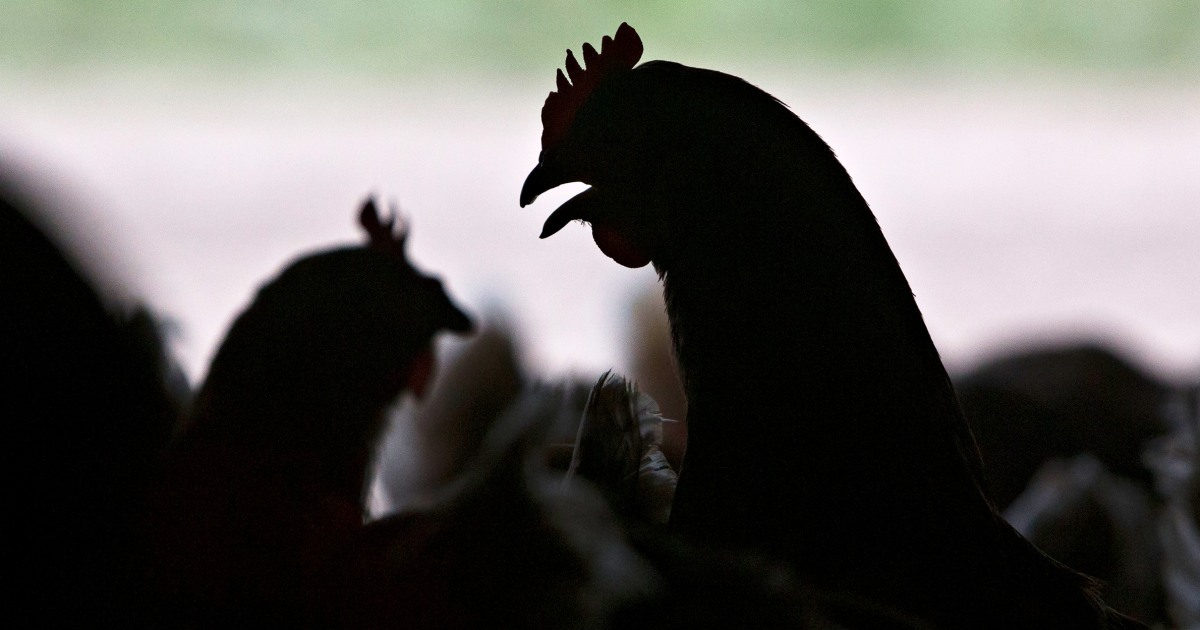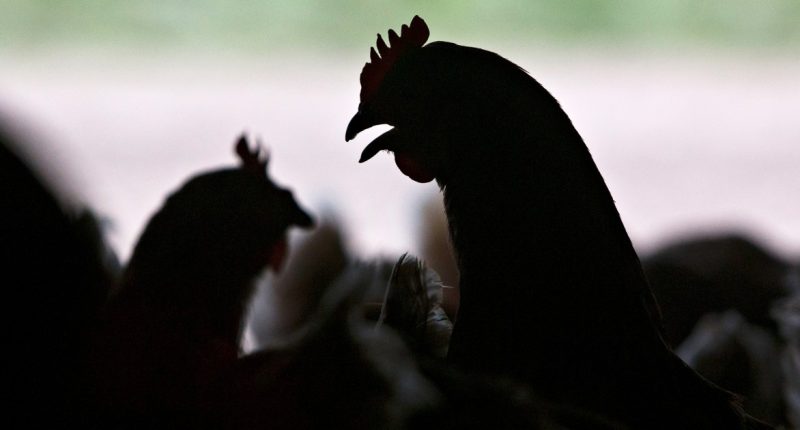
In early April, a dairy worker in Texas tested positive for avian influenza, also known as bird flu, amid a multi-state outbreak of the virus among cows. The bird flu virus has also been detected in raw milk, but authorities say the current risk to the public is low.
It’s the first time this strain of bird flu — referred to as highly pathogenic avian influenza A (H5N1) — has been detected in cattle and the first documented cow-to-human transmission of an avian influenza virus, according to the U.S. Centers for Disease Control and Prevention. The person in Texas is only the second case of bird flu in a human ever reported in the United States.
While there is no evidence of human-to-human transmission of the highly pathogenic H5N1 virus, health officials are on high alert.
In a recent press conference, a leading expert at the World Health Organization called the risk of the bird flu spreading to humans “an enormous concern.” Speaking to reporters on April 18, WHO chief scientist Dr. Jeremy Farrar warned that bird flu viruses are increasingly infecting mammals.
“The great concern … is that the virus evolves and develops the ability to infect humans and then critically, the ability to go from human-to-human transmission,” Farrar said.
Is bird flu a problem now?
The current bird flu outbreak is affecting cows in over a dozen dairy farms across the country. Although the risk to humans is considered low, health officials are calling for increased monitoring of infected animals and people exposed to them.
While the thought of “bird flu” may sound alarming and stoke Covid-19 pandemic fears, influenza among birds is not new.
“The current bird flu strain that we’re concerned with, H5N1, has actually been circulating around the world for quite some time,” said Dr. William Schaffner, professor of infectious diseases at Vanderbilt University Medical Center.
H5N1 is widespread among wild birds and is causing an ongoing outbreak among poultry in the U.S., according to the CDC.
What is bird flu?
Bird flu is a disease caused by infection with avian influenza type A viruses. Avian influenza A viruses occur naturally among wild aquatic birds, such as geese, ducks and swans, Schaffner said, but they can also circulate among domestic poultry.
“Bird flu viruses occasionally get into other mammalian species (like pigs). We’ve all heard of swine flu,” Schaffner said. Avian influenza A viruses can also infect horses, bats and dogs, per the CDC — rarely, they spread to humans.
“More recently, we have seen an increase of infections in cattle,” said Dr. Hilary M. Babcock, infectious disease specialist at Washington University of St. Louis and BJC Healthcare.
This is the first time the avian influenza strain of highly pathogenic H5N1, which causes severe and often fatal disease in birds, has been found in cows. “That’s pretty unusual,” said Schaffner. However, this H5N1 strain does not seem to be making cows very sick, he added.
What states have bird flu?
Highly pathogenic avian influenza viruses (which include the strain of H5N1 that’s currently spreading) have been detected in the U.S. in wild aquatic birds, commercial poultry and backyard bird flocks beginning in January 2022, according to the CDC.
Overall, 48 states have reported cases of highly pathogenic H5N1.
The current outbreak of H5N1 affecting cows has spread to eight states so far, per the U.S. Department of Agriculture. As of April 11, cases have been reported among dairy herds in:
- Texas
- Kansas
- Michigan
- New Mexico
- Idaho
- Ohio
- North Carolina
- South Dakota
Currently, only one human in Texas is known to have contracted H5N1 in this outbreak, experts say.
There have been only two human cases of H5N1 in the U.S. ever, said Babcock — the first case was detected in Colorado in 2022 in a person who had direct contact with infected poultry.
As H5N1 surveillance increases, experts anticipate the number of cases among cows to increase. “We’re looking harder now and finding more cases (among cattle) that even 10 years ago would have gone undetected,” Schaffner said.
The risk to the general public in the U.S. is low, experts say. For people exposed due to their line of work, the risk is considered “low-to-moderate,” the World Health Organization said in a statement.
How does the bird flu spread to humans?
“Every once in a while, a bird flu virus can get into a human, but that’s rare,” Schaffner said. Avian influenza viruses can spread from infected birds to humans in a few ways, according to the CDC:
- Directly from an infected bird
- From environments contaminated with avian influenza virus
- Through an intermediate host, such as an animal
Infected birds can shed the virus in their saliva, nasal secretions, mucus and feces. People can become infected when a large enough amount of the virus gets into the mouth, nose, eyes or is inhaled, Schaffner said.
Transmission to humans typically occurs through close contact with infected birds without protective gear. It can also occur if a person touches contaminated surfaces and puts their hands in their eyes or mouth or if they breathe in droplets from the air, per the CDC.
It was not immediately clear how the dairy cow infected the person in Texas, experts note. The only other person who contracted H5N1 in the U.S. was directly involved in the culling of birds presumed to be infected with H5N1, said Babcock.
Sporadic cases of H5N1 in humans have been reported around the world, often in rural areas where people live closely with poultry or other birds. According to the WHO, since 2003 there have been 889 cases and 463 deaths caused by H5N1 in 23 countries.
Once the bird flu gets into a human, “it is almost never spread to anyone else,” said Schaffner. However, “there are ultra-rare instances of transmission from a person very sick with bird flu to a family member or caregiver.”
No human-to-human spread has occurred with the contemporary H5N1 viruses currently spreading in birds, the CDC said.
When this does happen, it does not lead to continued spread between people “because the virus doesn’t have the (genetic) capacity to spread easily from person to person,” Schaffner said.
“This strain of bird flu has been around for about a decade and it still has not picked up this capacity to spread readily from person to person, thankfully. … That should be a matter of reassurance, but also keep us in public health on alert,” said Schaffner.
Can you get bird flu through eggs?
There is no evidence that people can get bird flu from food that’s been properly prepared and cooked, and it is safe to eat eggs, chicken and beef, and drink pasteurized milk, experts say.
“We have not seen cases that have been from ingesting animal products or animals that may have been infected,” said Babcock.
The infected dairy cow herds that have been detected are in quarantine and their milk is being destroyed, Schaffner said.
In a statement, the USDA said the commercial milk supply in the U.S. remains safe. The U.S. Food and Drug Administration said it does not currently have concerns about the safety of pasteurized milk products, including pasteurized cheese.
“The pasteurization process in the U.S. keeps our milk supply very safe,” Babcock said. Pasteurization heats the milk to a high enough temperature to kill bacteria and viruses, including influenza.
Drinking unpasteurized or “raw” milk, which is increasingly trendy, is associated with various infectious disease hazards, Schaffner said. “I discourage people from drinking raw milk,” he added.
The risk of humans becoming infected by eating eggs from poultry with H5N1 is low, the FDA says, and there are safeguards in place to identify infected poultry and remove their eggs from the market.
It’s possible for products from infected animals to end up in the food supply, said Babcock, but the risk to humans is still very low. Properly storing and cooking food further reduces that risk.
Although beef cattle are not involved in this outbreak, Schaffner recommends cooking beef to a safe internal temperature. The FDA recommends cooking eggs until the white and yolk are firm.
“There are other reasons that you shouldn’t eat raw eggs (or meat), because these can carry lots of different pathogens,” Babcock said.
What happens if a human gets the bird flu?
Bird flu infections in humans can range in severity, experts note. Some people have zero or only mild symptoms, while others develop severe disease, according to the CDC.
“It can be a serious infection with a high mortality rate,” Schaffner said.
The Texas patient had a mild infection, with eye redness as the only symptom, the CDC said. “It was not even a respiratory infection. It was … conjunctivitis or pink eye,” Schaffner noted.
The patient was treated with flu antivirals and is recovering. “We have antiviral medications, the same ones we use to treat regular flu, that work against this avian influenza strain,” Schaffner said.
The other human case of H5N1 in the U.S. in 2022 was a mild infection as well, Babcock added.
Symptoms of bird flu in humans
According to the CDC and experts, the reported signs and symptoms of avian influenza in humans include:
- Fever
- Cough
- Runny nose
- Muscle or body aches
- Headache
- Fatigue
- Shortness of breath
- Eye redness or inflammation (conjunctivitis)
- Diarrhea
- Nausea
Bird flu in humans may look similar to a regular flu or upper respiratory infection, said Babcock, or a person may have no obvious symptoms. It can also lead to pneumonia, respiratory failure and other complications. “There’s a full range,” she added.
There is no way to diagnose an infection with bird flu by symptoms alone, the CDC says. Laboratory testing is required.
Can you recover from bird flu?
Yes, you can recover from bird flu. The person recently infected in Texas was treated with flu antivirals and is recovering. The Colorado patient infected in 2022 also recovered.
Globally, bird flu symptoms have ranged from mild to severe, resulting in death in some cases, according to the CDC.
How to prevent spread of bird flu
Although the risk of getting bird flu is low, the CDC recommends the following protective actions:
- Avoid visiting poultry farms if possible
- If visiting poultry farms, wear a mask and avoid touching birds
- Avoid sick or dead birds
- Maintain good hand hygiene
- Do not eat raw or undercooked poultry
- Visit a doctor if you become sick after contact with birds
Source: | This article originally belongs to Nbcnews.com









